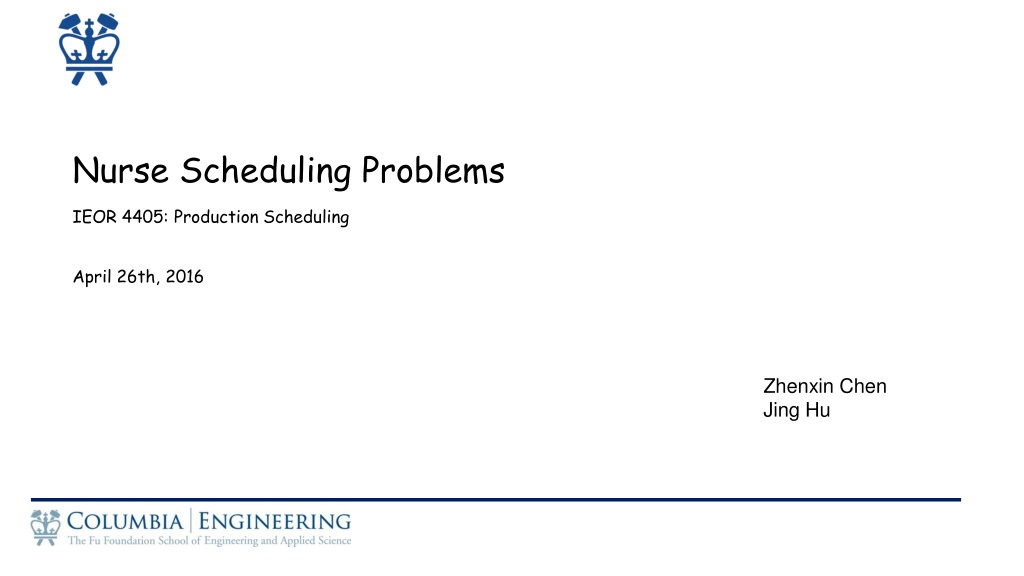
Optimizing Nurse Scheduling: Solutions and Challenges
Explore the complexities of nurse scheduling problems, including creating weekly schedules for hospitals, meeting demand for nurses of different grades, and ensuring fairness. Discover integer programming formulations, Bayesian network solutions, and efficient scheduling techniques.
Download Presentation

Please find below an Image/Link to download the presentation.
The content on the website is provided AS IS for your information and personal use only. It may not be sold, licensed, or shared on other websites without obtaining consent from the author. If you encounter any issues during the download, it is possible that the publisher has removed the file from their server.
You are allowed to download the files provided on this website for personal or commercial use, subject to the condition that they are used lawfully. All files are the property of their respective owners.
The content on the website is provided AS IS for your information and personal use only. It may not be sold, licensed, or shared on other websites without obtaining consent from the author.
E N D
Presentation Transcript
Nurse Scheduling Problems IEOR 4405: Production Scheduling April 26th, 2016 Zhenxin Chen Jing Hu
The Nurse Scheduling Problem Objective: Creating weekly schedules for wards containing up to 30 nurses at a Nottingham City Hospital Requirements: Schedules must respect working contracts Schedules must meet demand for a given number of nurses of different grades on each shift Schedules must be perceived to be fair by all nurses Nurse Shifts: Day Shift: (1) Earlies (2) Lates Night Shift Full-Time Nurse Shifts Example: 5 days/4 nights; Part-Time Nurse Shifts Example: 3 days/3 nights; Shift Pattern: 5 days/0 nights Usually there are 411 different shift patterns 3 days/2nights 0-1 vector with 14 elements 1111100|0000000 Problem Decomposition: Stage One: Knapsack Problem Stage Two: Allocation of days/nights for each nurse Stage Three: Create network flow model
Nurse Scheduling Integer Programming Formulation xij= 1 if nurse i works shift pattern j; 0 otherwise ajk= 1 if shift pattern j covers day/night k; 0 otherwise qis= 1 if nurse i is of grade s or higher; 0 otherwise pij= preference cost of nurse i working shift pattern j m = number of shift patterns n = number of nurses p = number of grades F(i) = set of feasible shift patterns for nurse i range from 0(perfect) to 100(unacceptable) (1) Objective function: Minimize total preference cost of all nurses (2) Shift pattern constraint: every nurse works exactly one shift pattern (3) Demand constraint: demand for nurses is fulfilled for every grade on every day & night
BOA for Nurse Scheduling - Bayesian Network for Nurse Problem Bayesian Networks (Directed Graphical Models) Node: a nurse/rule pair, nurse i is assigned by rule j Edge: causal relationship of Nij causing Ni+1,j Potential Solution: directed path from nurse 1 to nurse m connecting m nodes Fixed network structure: all variables are fully observed
Baysian Network Example Three nurses & three rules scheduling Scheduling process repeated 50 times and each time rules are randomly used to get a solution Number on the edge represents the total number of times this edge has been used in 50 runs
Baysian Network Example - Probability Calculation First rule in a solution has no parents, it will be chosen from nodes N1j according to their probabilities. Next rule will be chosen from nodes Nij according to the conditional probabilities. Building process is repeated until the last node Nmj has been chosen. A path formed from Nurse 1 to Nurse m, as a new potential solution
A Greedy Double Swap Heuristic Objective: A greedy double swap heuristic for nurse scheduling satisfies not only hard constraints, but also soft constraints Hard constraints: regulatory requirements, patient demands, etc., can be formulated into mathematical programming H1: Minimum Rest Days Constraint; H2: Maximum Consecutive Work Days with Rest Day constraint; H3: Nurse Requirement Constraint; H4: Annual Leave and Training Leave Constraint; H5: No consecutive shift constraint; Soft constraints: We take penalty cost as the indicator of preference. The higher the penalty cost, the lower the preference, and vice versa. S1: An afternoon shift should not be followed by a morning shift the next day; S2: Continuous rest days are not preferred unless it meant to follow 4 consecutive night shifts; S3: A rest day should be followed by more than 1 work day; S4: Three or four consecutive night shifts are not preferred. Greedy double swap heuristic(GDSH): Two-phase algorithm Pros and cons - -
Hard Constraints Mathematical Programming Formulation H4: Annual leave and training leave constraint H1: Minimum rest day constraint H2: Maximum Consecutive Work Days with Rest Day constraint H5: No consecutive shift constraint H3: Nurse requirement constraint
Greedy Double Swap Algorithm Initialization total number of nurses meets the total duty Initialization requirements Read in the parameters. Calculate the manpower supply and demand. I. If demand exceeds supply, terminate. II. Else, continue. 3. Initialize an initial schedule of the nurse based on the nurses required number of working days. This initial solution may violate the hard constraints. 4. Input the required days for leave of absence. 1. 2. initialize the initial schedule of nurses will probably not satisfy the hard constraint define the required days for leave of absence
Greedy Double Swap Algorithm-Phase I and Phase II Phase I Swap the shift for day i and day j for nurse n. To find schedules that meet the hard constraints For each iteration, we adapt the schedule that improves the percentage of hard constraints met after swap Phase II To minimize the penalty cost function incurred by every nurse. The lower the penalty cost means that the higher the nurse s preference on that schedule. Phase 2 - Double swap with minimization of penalty cost 1. Calculate the total penalty cost incurred by every nurse. Search for the nurse n which contributes most to the penalty cost objective function. Select another nurse m randomly. Randomly select two days i and j. Swap shifts of nurse n and m for day i and day j. Check for hard constraints conditions. If there is violate, reverse and move;else, continue. 7. If step 6 continues, check for penalty cost objective function improvement. If there is no improvement, move and reverse; otherwise, continue. 8. Repeat steps 1-8 until penalty cost objective function equal to 0 or iterations exceed 10,000. 2. 3. 4. 5. 6. Phase 1- First swap between shifts for the same nurse 1. Randomly select a nurse n. 2. Swap the shift for day i and day j for nurse n. 3. Check for hard constraints condition. I. If the percentage of hard constraints met improves, then use the new solution. II. Use back the old solution. 4. Repeat steps 1 to 3 until 100% of hard constraints are met or iterations exceed 1,000,000.
Greedy Double Swap Heuristic(GDSH)-Evaluation The paper by Murphy Choy and Michelle Cheong s paper provides valuable simulation results for evaluating the greedy double swap heuristic. Compare to simplified version of the NSP problem, GDSH takes soft constraints, namely, nurses preference into consideration. Higher feasibility means higher percentage of the constraints met. (100 simulations runs for a case of 6 nurses without any specialist training for a single ward for a 5-day schedule) Get result quickly. (100 simulations run for 15 nurses with specialist requirements for a single ward for a 14-day schedule) Limitation 10% of the simulation runs resulted in failure. It cannot account for cases where multiple swaps among several variables are needed to meet the hard constraints. Have assumed a preference structure which is uniform among the nurses.
Further Studies We ve obtained 52 real data sets, each data set consists of one week s requirements for all shift and grade combinations and a list of available nurses together with their preference costs pij and qualifications Data was collected from three wards over a period of several months and covers a range of scheduling situations We will make comparisons, identify pros and cons


